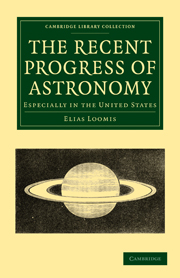Book contents
- Frontmatter
- PREFACE
- Contents
- CHAPTER I RECENT ADDITIONS TO OUR KNOWLEDGE OF THE PLANETARY SYSTEM
- CHAPTER II RECENT ADDITIONS TO OUR KNOWLEDGE OF COMETS
- CHAPTER III ADDITIONS TO OUR KNOWLEDGE OF FIXED STARS AND NEBULÆ
- SECTION I
- SECTION II
- SECTION III
- SECTION IV
- SECTION V
- CHAPTER IV PROGRESS OF ASTRONOMY IN THE UNITED STATES
- POSTSCRIPT
- Frontmatter
- PREFACE
- Contents
- CHAPTER I RECENT ADDITIONS TO OUR KNOWLEDGE OF THE PLANETARY SYSTEM
- CHAPTER II RECENT ADDITIONS TO OUR KNOWLEDGE OF COMETS
- CHAPTER III ADDITIONS TO OUR KNOWLEDGE OF FIXED STARS AND NEBULÆ
- SECTION I
- SECTION II
- SECTION III
- SECTION IV
- SECTION V
- CHAPTER IV PROGRESS OF ASTRONOMY IN THE UNITED STATES
- POSTSCRIPT
Summary
To common observation, the fixed stars retain sensibly the same relative position from age to age; but the exact observations of modern astronomy have detected a relative motion in a large number of them. A small star in the leg of the Great Bear (called 1830 Groombridge) has an annual motion of seven seconds of arc as compared with neighboring stars; and there are more than thirty stars known, whose annual proper motion exceeds one second. It might have been expected, a priori, that motion of some kind must exist among such a multitude of objects all subject to mutual attraction; and it appears highly probable, not to say certain, that the sun must participate in this movement. The effect of a motion of the sun, with reference to the stars, would be an apparent divergence or separation of those stars toward which we were moving, and an apparent convergence or closing up of the stars in the region which we were leaving. We might therefore expect to detect such a motion, if it really exists, by comparing the proper motions of all the stars in the firmament. In accordance with this idea, Sir William Herschel, in 1783, by a comparison of the proper motions of such stars as were then best ascertained, arrived at the conclusion that the sun had a relative motion among the fixed stars, in the direction of a point in the constellation Hercules, whose right ascension is 260° 34′, and declination 26° 17′ north.
More recently, M. Argelander, by comparing the proper motions of 390 stars, has located this point in right ascension 257° 35′, and declination 36° 3′ north.
- Type
- Chapter
- Information
- The Recent Progress of AstronomyEspecially in the United States, pp. 189 - 195Publisher: Cambridge University PressPrint publication year: 2010First published in: 1856

